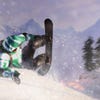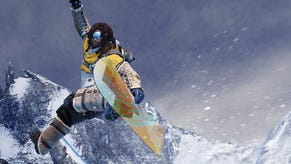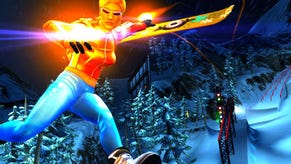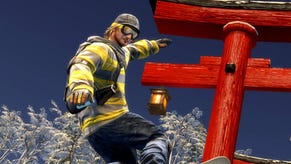SSX
Deadly dissent.
It's fast and vertiginous, but the tracks have been designed with a view to presenting racers with a good deal of freedom across multiple paths. EA Canada expects finding the best shortcuts and fastest or safest lines to add replayability and a sense of adventure to this race mode.
The track ends with our racer leaping across a huge crevasse with the aid of a helicopter, grabbing onto its runners for a lift (there will also be a Pilotwings-style wing suit for protracted aerial glides). Featured prominently in the trailers for the game, helicopters will be companions and familiars for the SSX riders, dropping them at and collecting them from event locations, assisting races or dropping flares to guide you along dark courses.
Next it's off to the Himalayas - yes, Mount Everest will be in the game, and you'll be able, with glorious improbability, to board right from its summit - for some tricking. This activity generally takes place at lower altitude on softer, more forgiving and more open terrain. Today we visit Makalu on the border between Tibet and China, so - in another deliciously silly flourish - we can grind along the Great Wall of China.
The goal for the trick mode is to capture the style, flow and sense of self-expression of old SSX or the early Tony Hawk games, we're told. You can use either an old-school button configuration or the more modern twin-stick approach; I use the latter when I get to try the mode out and it is very fluid, responsive and slick.
A few minutes is nowhere near long enough to tell if it has the requisite depth, but it's certainly an effortless and flowing ride. There's a great sense of freedom to the environments too, with no artificial restrictions to your movement and a physics system, rather than design scripting, dictating which edges you can grind.
Even the deadly descent "boss fights" are only so scripted. These nine challenges are summit descents on the "gnarliest terrain that we could find". Each acts as the final challenge of a geographical region and gateway to the next, and each has a particular hazard as its theme: snow, rock, ice, thin air, gravity, fog, wind, whiteout and darkness.
We're at the highest peak in North America, Denali (otherwise known as Mount McKinley) in Alaska, and our enemy is snow. What that means in practice is procedurally generated avalanches created by your own snowboard: everywhere in the game, the terrain is subject to a stability analysis, and the forces you exert on the snow while riding - a heavy landing, a hard carve at high speed - have the potential to loosen snow, creating spray, slough, slides and even different categories of avalanche.
The deadly descent sees us plummeting 1500 metres down the south face of Denali in a dim twilight, the boarder's head lamp flickering across the snowscape and a frightening apron of tumbling snow chasing him down the sheer face of the mountain.
Although offering fast and extravagant action, SSX generally isn't afraid to pull the camera far back from the boarder and simply fill the screen with white mountainside, to great effect. This deadly descent unusually reverses the camera angle, looking back towards the mountain and the boarder tumbling down it in a distant, almost 2D presentation that looks like filmed helicopter coverage. It's really effective, although hard to imagine how it maps to the controls. The demonstrator only makes it halfway down before being engulfed in his own wake of snow.
The fact is, SSX isn't really what was suggested by either its first appearance as Deadly Descents, or its subsequent, minimal rebranding. It looks, very unusually for an extreme sports sequel, like a game made to high standards, with considerable creative and technical ambition, but also sensitivity to its arcade roots. It might not be the game SSX fans imagined - but it probably is the game they've been waiting for.













